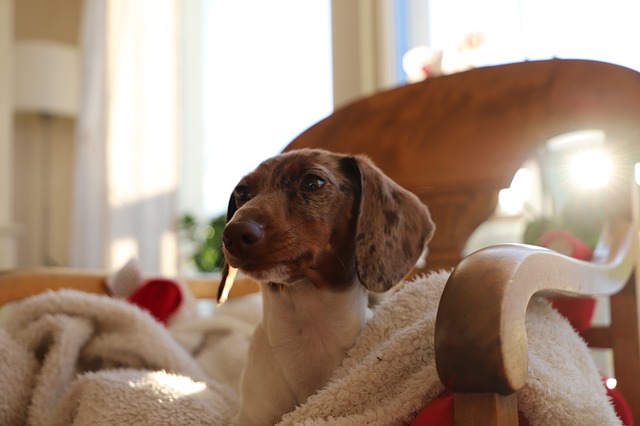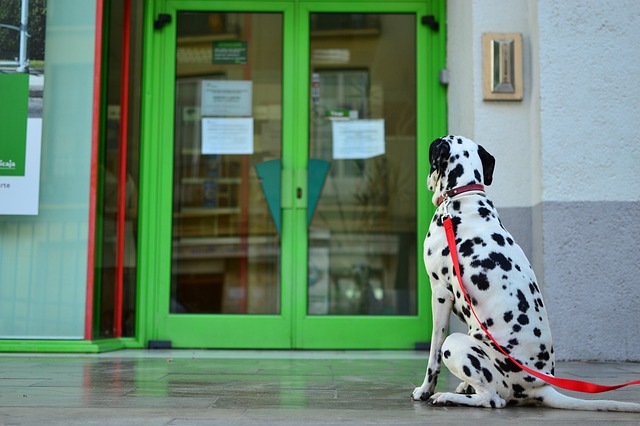Does the sound of you picking up your car keys make your dog quake in fear? Have you gotten complaints from your neighbors that your dog barks nonstop every time you leave your house? Do you often come home to destruction, especially around doors and windows?
Your dog may be suffering from separation anxiety. This problem can be debilitating for your dog and frustrating for you. Helping your dog overcome separation anxiety isn’t easy, but it is possible.

Symptoms of Separation Anxiety
While some of these symptoms can represent other problems on their own, a dog that displays more than one symptom while left alone is likely suffering from separation anxiety.
- Peeing or pooping in the home (only when alone)
- Barking or howling
- Chewing, digging, or being destructive, especially around doors or windows
- Excessive panting or drooling
- Escaping
- Refusing to eat or drink when alone
- Pacing

A dog that has accidents in the house when there are people around likely has potty training or health issues rather than separation anxiety. Destructive dogs may just be bored or not getting enough exercise.
If your dog experiences sudden behavioral changes that don’t seem to be tied to household changes (like a child leaving for college or a divorce), then you should contact your vet to see if medical problems may be causing your dog’s symptoms. If you think your dog has separation anxiety, you may need to contact a dog trainer who specializes in separation anxiety. It can be quite difficult to treat.
How to Help Your Dog Overcome Separation Anxiety
For Mild Separation Anxiety
A dog with mild separation anxiety can be taught that good things happen when they’re left alone. By giving your dog special things only when you leave the house, he learns to associate you leaving with receiving a toy stuffed with peanut butter, a puzzle toy filled with treats, or a little bit of boiled chicken. If you only give your dog these special treats when you leave, he will have something to look forward to when you leave instead of something to be upset about.

For Moderate to Severe Separation Anxiety
Many dogs will start to panic the moment you leave the house, or even before you leave the house, and will be too upset to be bribed by treats. This makes training much more difficult and time-consuming. You may need to consult a Certified Applied Animal Behaviorist (CAAB or ACAAB), a board-certified veterinary behaviorist (Dip ACVB), or a Certified Professional Dog Trainer (CPDT) who has experience dealing with dogs who suffer from separation anxiety.
Related: Kingdom Of Pets Online Dog Training Review 2023
In short, the only way for a dog to completely get over separation anxiety is for him to learn, a little bit at a time, that you will always come back. Ideally, your dog should never be left alone for longer than he can handle during this entire process. This may require doggy daycare, pet sitters, or help from family members if your dog panics the moment you leave the house.
Here are some steps you can take to help your dog overcome his anxiety.
First, if your dog starts to become anxious as soon as he can tell you’re getting ready to leave the house (like putting on your shoes or grabbing your keys) then you need to start mixing up your routine and doing part of your leaving routine when you aren’t leaving.
If your dog starts to quake at the sound of your keys jingling, for example, grab them periodically throughout the day and put them in your pocket without leaving the house. If putting on your shoes is your dog’s trigger, put on your shoes and then wear them around the house without leaving. And if the sound of your alarm is a trigger, then you need to set that alarm on the weekend, too, even if you just get up to go to the bathroom before crawling back into bed.
Related: The 10 Best Anti-Anxiety Beds for Dogs

The key is to desensitize your dog to the cues he has associated with you leaving him alone.
Once your dog is less nervous about your departure cues, it’s time to start getting him used to the idea of you leaving. Leave the house for a few moments, then come back in like it was no big deal. Later, leave the house and walk around the block before coming back. If your dog is already panicking, go back to just putting a door between yourself and your dog before coming back inside.
Gradually, you can start leaving your dog alone for longer periods of time. Once your dog can stay home alone for 90 minutes at a time, he is probably OK to stay alone for a few hours, although he may never be happy about spending all day alone.
Another key to helping your dog with separation anxiety is to make coming and going as nonchalant as possible. Spending a lot of time fawning over your dog before you leave puts him into an excited state and it will be harder for him to calm down. Likewise, when you come home, your dog will be excited to see you, but you shouldn’t reward that excitement with your attention. Ignore your dog for the first five minutes after you come home until he has settled down. Make it so that your return is no big deal instead of a big, exciting event.

More Suggestions
The more physical and mental stimulation you can give your dog when you are home, the less overall stress your dog will experience, which can help him overcome his anxiety. Make sure your dog gets at least 30 minutes of exercise every day. Play interactive games with him, take him for a different route on each walk, and challenge him with puzzle treat toys to engage his brain.
For severe cases of separation anxiety, medication may be required to reduce your dog’s anxiety to a level that you can work with. If you can’t even put a closed door between yourself and your dog, talk to your vet about adding an anti-anxiety medication to your dog’s treatment plan. It could mean the difference between success and failure at overcoming his separation anxiety.
There are many natural ways to help relieve your dog’s anxiety, as well. The more things you can try, the more likely it is that you will find a way to help relieve your dog’s anxiety (along with behavioral modification training, of course – usually no one thing works by itself). Some examples include pheromone diffusers, ThunderShirts, Comfort Cuddlers, and dog-friendly essential oils (like lavender).
Many pup-parents have also reported good results using Hemp oil. We recommend Cannanine™ Organic Full Spectrum Hemp Oil.

The most important thing to remember
The most important thing you need to keep in mind that you should NEVER punish your dog for being destructive or having accidents in the house when you are gone. Your dog isn’t trying to punish you for leaving them alone – they are having a full-blown panic attack.
Punishing your dog for being anxious will only make him more anxious. As frustrating as it can be to come home to a torn up sofa or a puddle of urine, it’s crucial to remember that your dog is acting out of fear, not spite.
 Toledo, United States.
Toledo, United States.